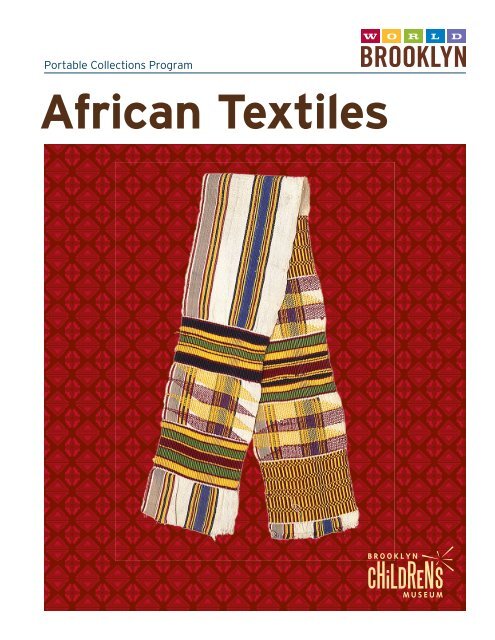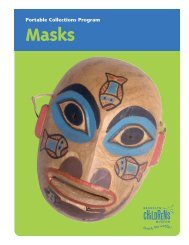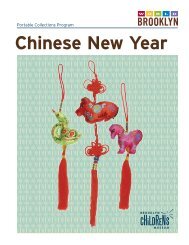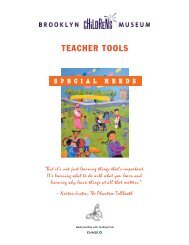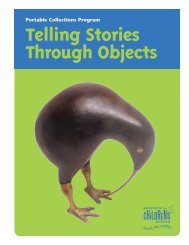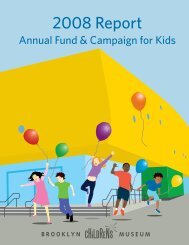African Textiles - Brooklyn Children's Museum
African Textiles - Brooklyn Children's Museum
African Textiles - Brooklyn Children's Museum
You also want an ePaper? Increase the reach of your titles
YUMPU automatically turns print PDFs into web optimized ePapers that Google loves.
information for the teacherWelcome!This case will introduce students to the rich traditions of some <strong>African</strong> textiles. By studying thematerials and completing the activities in this case, students will learn about Africa’s culture andits peoples through their textile art.The case’s activities and resources focus on three of Africa’s most well-known textiles: kente,adinkra, and adire. The case provides students with opportunities to create original adinkra art,make their own wearable adire cloth, and design their own kente pattern.The study of <strong>African</strong> textiles can extend in many directions, such as other <strong>African</strong> arts, and crafts,<strong>African</strong> American heritage and history, <strong>African</strong> geography, and even botany. We have includedsome suggestions on how to make these curriculum connections to serve as starting pointsfor your own and your students’ interests. Integrated classes were taken into consideration whendeveloping these activites, making many suited for students with special needs. For your convenience,you can download this guide from our website: www.brooklynkids.org.The objects in this case are real and authentic. Some are from the <strong>Museum</strong>’s collection andothers were purchased from stores that import <strong>African</strong> products. Because many are made ofnatural materials, they are especially fragile. It is important to emphasize and model to yourstudents that, like all museum objects, these are to be handled carefully.<strong>African</strong> <strong>Textiles</strong> | 6
information for the teacherInformation About Objects In The CaseKente Cloth Strip, Ghana, 20th century (object #64.53.4) Kente isa colorful cloth with bright patterns that is woven in thin strips and sewntogether into a large cloth. Traditional kente cloth is worn in large sheets thatare wrapped around the body. Many long, thin strips like this one are sewntogether to make a large sheet. Traditional kente is still made by hand. Oncethe cloth for kings, today kente is worn by many people on special occasions.Kente Cloth Scarf, Ghana, 2008 (object #2008.1.1) Kente is a traditionaland distinctive type of cloth woven of strips like the single one also includedin the case. This scarf is made up of four strips. The weavers of this kentescarf are members of a family named Gobah Tengey-Seddoh. The family hasbeen weavers since 1821. It now consists of twelve brothers and sisters whoare managed by an elder, Fred Gobah Tengey-Seddoh. Gobah Tengey-Seddohproduce contemporary kente products like this scarf and also bedspreads, placemats, bags and other things that are far from the original, traditional use ofkente as prestige costume for royal persons. The scarf was purchased online.Printed Kente Cap Kente is recognized all over the world as a symbol ofAfrica. Some people in the United States wear kente or items printed withkente patterns to celebrate their <strong>African</strong> heritage.Cloth Napkin, Liberia, late 20th century (object #96.11.6) The napkinis hand-woven white cotton that was tied like the white example in the caseand dipped into indigo dye. After the dye dried, the ties were removed to revealthe pattern and the edges were unraveled to make the fringe. The museumowns a matching tablecloth and set of napkins. It is quite possible that this wasmade for the American market rather than for local use.Cloth Tied for Dying, Senegal, mid-20th century (object #72.76.32b)Tie dying is one of several methods of creating patterns by preventing dye fromreaching certain parts of a cloth. These methods are collectively called “resistdying.” The cloth is tied the way it is in this example, dipped into a vat of dye,dried, and then the ties are undone. Where the ties were remains the color ofthe original cloth, in this case white. This example is tied in a way that willresult in a simple pattern of concentric white circles. More complex patternsare usually drawn on the cloth, which is then tied along the pattern lines.Wax Resist-Dyed Textile, Guinea, late 20th century (object #96.11.4)The cracking of wax applied to the surface of the textile when it was dippedin dye resulted in the intended design of mysterious dark splotches and lineson this textile. The wax protected the large background areas, but the dyeleaked artistically through the cracks. Wax resist is a form of adire. What isunusual about this textile is that the pattern is so diffuse. On the other hand,dying over a woven pattern as in this piece is not so unusual and adds a subtlecomplexity.<strong>African</strong> <strong>Textiles</strong> | 10
Activities to do with your studentsACTIVITY 1Introduction to <strong>African</strong> <strong>Textiles</strong>Grades: AllRelated ObjectsKente ScarfCloth NapkinWax ResistDyed ClothAdire WrappingClothAdinkra ClothSenegal Cloth“7-Up” ClothStudents will gain an overview of <strong>African</strong> textile making traditions and begin to explore the trade,craft, and colors of <strong>African</strong> cloth by closely examining the textiles in the case.Guiding Questions:1. What are textiles?2. What are textiles used for?3. Where do you use textiles?4. Why are textiles important?5. What can textiles tell us about the person wearing them?6. What do the clothes you wear say about you?<strong>African</strong> <strong>Textiles</strong> | 12
Activities to do with your studentsMaterialsWorld MapArts of Ghana DVDWhat Can Objects Tell Me? worksheetPencilsWhat To Do1. Write Africa and the United States of America (U.S.A) on theboard in large letters. Ask students to find Africa on the map.Introduce where Africa is (the DVD has two chapters whichshow streets in Accra and a typical market) and how people fromAfrica live around the world including here in New York City.2. Pass out the What Can Objects Tell Me? worksheet. Discuss theways we can learn from objects just by examining them closely.Have students look closely at an article of clothing they arewearing, such as their shirts. Have them consider: How manyparts or sections does your shirt have? Was it made from onepiece of cloth? Ask them to imagine making a shirt from scratch.You may also want to look at the types of shirts people arewearing and ask them to think of the reasons why you mighthave a shirt for special occasions and another one for play.3. Introduce the idea that we can use a similar approach to learnfrom objects we may have never seen before. Explain that theywill be looking closely at examples of <strong>African</strong> textiles to learnmore about how and why they are made and used.4. Show students a selection of textile pieces from the case. Passthem around one by one. Ask your students to examine thetextiles and share what they see and feel: When you look at thecloth can you draw any conclusions about how it was made?What colors do you see? Does it look familiar to you? Whatdoes the fabric make you think of? What would you make outof it? Which cloth do you like best? Write their impressions onthe board and invite your students to write their notes on theirobject study forms. After all the objects have been examinedask students to compare them: How would you describe thedifferences between the patterns?Try this alternative For younger students or students with special needs use theWhat Can Objects Tell Me? worksheet as a lesson review and have students fill in theboxes with verbal responses.<strong>African</strong> <strong>Textiles</strong> | 13
<strong>African</strong> <strong>Textiles</strong>What Can Objects Tell Me?Look at each object closely. What kinds of things can we learn about an object just byexamining it closely? What do objects tell us about the people who made them? Use this chartto record everything you discover.ObjectDescribe the colors,shapes, and patternsyou see.What things does theobject remind you of?How do you thinksomeone might usethis object?© 2008
<strong>African</strong> <strong>Textiles</strong>ObjectDescribe the colors,shapes and patternsyou see.What things does theobject remind you of?How do you thinksomeone might usethis object?© 2008
Activities to do with your studentsACTIVITY 2<strong>African</strong> Textile Making Video & JournalGrades: AllRelated ObjectsKente ScarfCloth NapkinWax ResistDyed ClothAdire WrappingClothAdinkra ClothSenegal Cloth“7-Up” ClothStudents watch a video on <strong>African</strong> textile making traditions and create their own album of imagesand impressions about the textiles in the case.Guiding Questions:1. How do you think the textiles were made? What do you see that makes you think that?2. How do you think the textiles are used? What do you see that makes you say that?<strong>African</strong> <strong>Textiles</strong> | 16
Activities to do with your studentsMaterialsWorld MapArts of Ghana DVDWhat Can Objects Tell Me? worksheetConstruction paperStaplerScissors (safety scissors for special needs students)Glue or tapeBooks and magazines on <strong>African</strong> cultureComputer w/printerPencilsWhat To Do1. Review your students’ impressions of the textiles from thecase (have them refer to their What Can Objects Tell Me?worksheet). Ask them to consider how they think the textileswere made and used. Write their impressions on the board.2. Play the DVD (show Weaving and Adinkra chapters). Introducethe video by explaining that they are going to watch a videoabout people in Africa who make fabrics like the ones they werejust looking at.3. After the video, invite students to add any additional impressionsor comments about the fabrics to the list on the board.4. Tell students that they will be creating their own “<strong>African</strong> TextilePicture Books.” Hand students two or three pieces of constructionpaper. Demonstrate how to fold the paper in half and staple it tomake a book.5. Instruct students that these books will be used as a journalthroughout the unit to record their impressions of <strong>African</strong>textiles. Direct students to draw images, use magazine pictures,make copies of pictures in books, or use the Internet as aresource. Encourage them to use pictures that include peoplewearing and making <strong>African</strong> textiles.<strong>African</strong> <strong>Textiles</strong> | 17
Activities to do with your studentsACTIVITY 3:Create a Kente Cloth DesignGrades: 3-5Related ObjectsKente Strip Kente Scarf Kente CapStudents will hear an <strong>African</strong> folktale about kente cloth and then design their own kente cloth.Guiding Questions1. What is weaving?2. What other things do you know that are woven?3. Have you seen a loom before? Where?4. How is traditional kente cloth made?<strong>African</strong> <strong>Textiles</strong> | 18
Activities to do with your studentsMaterialsThe Spider Weaver: A Legend of Kente Clothby Margaret MusgrovePhotos of kente patternsArts of Ghana DVDKente Strip templates (to be prepared by teacher)8 “ x 11” white paperColored pencils or waterbase markersGlue or tapeWhat To Do1. As an introduction to the kente lesson, read The Spider Weaverto your students.2. Lead a discussion on how kente cloth is made. See if they canrecall what they saw in the video (you may want to play thechapter on kente cloth weaving again). Pass the kente strip andscarf around and encourage students to look closely at theirpatterns and to feel their textures.3. Tell students that they will be designing their own kente. Providestudent with kente strip templates, colored pencils or waterbasemarkers, glue, and plain sheet of paper (their blank cloth).4. Have students consult resources for models and then color intheir templates. Instruct students to tentatively place strips onthe large paper backing and consider their composition. Oncetheir design layout is complete have students glue or tape theirtemplates onto the blank piece of paper.5. When finished, have students write an identifying label for theircloth: “Kente is… It was designed by…” (It may be helpful to givethem the start of each sentence).6. Hang the “cloths” with labels in the classroom for the durationof the unit.<strong>African</strong> <strong>Textiles</strong> | 19
<strong>African</strong> <strong>Textiles</strong>Kente Strips© 2008
Activities to do with your studentsACTIVITY 4:Make a Resist-Dye ClothGrades: 3-5Related ObjectsCloth NapkinCloth Tiedfor DyeingWax ResistDyed ClothAdire WrappingClothBased on a dye-resist process used by the Yoruba people of Nigeria, students will design andcreate their own wearable adire. Though students may recognize tie-dye, they may not knowthat it is a Yoruba craft.Guiding Questions1. What do you notice about the patterns?2. How would you describe the patterns? Are they symmetrical, centered, or random?3. How do you think the adire patterns might have been made?MaterialsAdire Designs sheetPlain white 100% cotton t-shirts(students bring in/teacher supplies)Wire hangers (students bring in/teacher supplies)Non-toxic dark blue fabric dyeWaterFour large plastic tubsRubber bandsMarbles/rubber balls (size doesn’t matter, but larger will beeasier for small hands to manipulate)Rubber/latex glovesOutdoor space with water supplySmocksPlastic sheets to protect floors and tabletops<strong>African</strong> <strong>Textiles</strong> | 21
Activities to do with your studentsBefore You BeginTry to recruit volunteers to help you with this activity.Volunteers can be used to assist students in tying and dyeingfabric and setting up workstations.Set up four tying workstations. Each station should includerubber bands and marbles/rubber balls.Set up two dyeing workstations. Each station should beequipped with two large plastic tubs filled with dye (see boxfor instructions). Have latex gloves and smocks available forstudents.Set up two rinsing workstations. Each station should beequipped with two large plastic tubs filled with water. Have latexgloves and smocks available for students.If possible, try to do this outdoors as dyeing can be messy. This maybe easier than protecting floors and tabletops with plastic sheets.You will need a place for drying the t-shirts. This may be outsideif it’s a nice day or somewhere inside your classroom. A strongcord tied across the classroom is a simple solution.What To Do1. Allow students to examine the various adire samples and guidethem in drawing conclusions as to how the designs might havebeen made: stitched, tied, or painted? Using the objects, introduceadire cloth and the various resist-dye techniques that can beused to accomplish the different designs.2. Hand out and review the Adire Designs sheet and review theinstructions on how to create different tie-dye designs.Demonstrate how each effect is achieved. Hold up the clothnapkin and ask students to refer to their Adire Designs sheetto guess how the design was created.3. Make sure each workstation is equipped with rubber bands andmarbles/balls. Before beginning, ask students to write theirname in permanent marker on the collar or back of their t-shirt.Encourage students to design their own adire using the materialsprovided and the design template as a guide.4. When students have finished tying fabric, bring the class over tothe dyeing station (invite parent volunteers to help). Have a fewcontainers ready: two containers filled with dye (follow boxdirections) and two filled with clear water. If you have to do thisinside, make sure to protect tabletops and floors with plasticsheeting.7. Wearing smocks and latex gloves, have students put theirt-shirts in the dye baths. Explain to them the longer the t-shirtstays in the darker their cloth will be.<strong>African</strong> <strong>Textiles</strong> | 22
Activities to do with your students9. After soaking for 15-20 minutes, remove the cloths and placethem in rinsing containers of clear water. Have students rinsecloths, squeezing cloth until the water runs clear and no moredye runs out (this may require several changes of water).10. Once rinsed, have the students remove their rubber bands toreveal their designs.11. Have students put their shirts on a wire hangar. Hang theirprojects to dry on the line in the classroom or outside.Try these alternatives• Use Elmer’s glue to draw a design on a piece of cloth. After the glue dries, use a spray bottle(filled with watered down permanent ink) to spray color onto the cloth (lay the cloth on somenewspapers). Hang dry on a line using clothespins. After they dry, gently scrape away theglue. Wash the fabric in warm water and the glue will dissolve. (Fabric markers can be usedinstead of watered down ink.) Have your students refer to the Adire wrapping cloth for designinspiration and as a sample of this type of resist-dye method.• Pour a small amount of blue food coloring into the wells of a plastic egg carton and add adrop or two of water. Fold a paper towel into a small square, rectangle or triangle. Dipthe corners of the folded paper towel quickly. Open the towel slowly to reveal a beautifulsimulated tie-dye design.<strong>African</strong> <strong>Textiles</strong> | 23
<strong>African</strong> <strong>Textiles</strong>Adire DesignsMethod 1:Rubberbands OnlyResult:LinesMethod 2:Marble + One RubberbandResult:CirclesMethod 3:Marble + Several RubberbandsResult:Sunburst© 2008
Activities to do with your studentsACTIVITY 5:Design & Make a Classroom Adinkra ClothGrades: 3-5Related ObjectsAdinrka StampAdinkra ClothStudents will gain an overview of adinkra cloth including the meaning of some of the mostpopular symbols, how adinkra is made, and then create their own adinkra cloth.Guiding Questions:1. What is a symbol?2. Where do you see symbols? (Display the picture symbols you collected and discuss.)3. Look for symbols on your clothing and jewelry? What symbols do you see?MaterialsRulersPencilsBlack non-permanent stamping inkAdinkra Symbol GuideAdinkra stamp setsAdinkra Cloth Design GridCraft paper or table cloth to protect tabletopsBefore You BeginCollect picture symbols that students are familiar with such asStar of David, Christian cross, peace, Nike, Puma, etc.Set up two stamping workstations. Cover each station with craftpaper or a washable tablecloth and place a set of stamps andstamping ink.<strong>African</strong> <strong>Textiles</strong> | 25
Activities to do with your studentsWhat To Do1. Using the objects from the case, introduce adinkra cloth toyour students. Lead a discussion on how adinkra cloth is made.See if students can recall what they saw in the video (you maywant to play the chapter on adinkra cloth again). Invite studentsto gather around the adinkra cloth and stamp. Have studentsdescribe what they see—patterns, arrangement of patterns, gridlines, etc.2. Hand out the adinkra symbol guide and review the differentsymbol meanings. Point out the use of some of the symbolson the Adinkra Symbol Guide with those on the cloth from thecase. Ask students to consider what the adinkra cloth may meanbased on the Adinkra Symbol Guide.3. Model planning an adinkra cloth design. Have students help youconsider the different meanings of the stamps as well as theoverall cloth design. Using the stamps, demonstrate how studentsshould create their adinkra cloth. Show them how they canchoose to repeat the same pattern multiple times in each box orjust stamp their design once.4. Split the class into small groups (three to four students) andprovide each group with an Adinkra Cloth Design Grid, paper,and pencils. Instruct students that each group will be creatingan adinkra cloth design.5. When cloth design is set, instruct students to take turns at thestamping stations to stamp their paper cloths.6. Once adinkra designs are stamped, have groups write a briefdescription of the meaning of their cloth. Hang the cloths withtheir descriptions in your classroom or hallway for the durationof the unit.Try this alternative Make a classroom Adinkra cloth. Using one enlarged template (postersize) demonstrate how students can choose a symbol and stamp it once or multiple times in abox. Have students come up individually and add a symbol to the cloth.<strong>African</strong> <strong>Textiles</strong> | 26
<strong>African</strong> <strong>Textiles</strong>Adinkra Symbol Guidethink ahead welcome learn from your mistakes good living two heads are better than onehand come, hand go congratulations wisdom/knowledge good-bye have couragestrength faithfulness enjoy yourself royalty good fortunegive me your heart forgiveness faith i shall meet you again hopetwo good friends you have changed house of peace the king sees all understandingtruthi salute youperforming the unusual/impossiblelove eyedrumpeace© 2008
<strong>African</strong> <strong>Textiles</strong>Adinkra Cloth Design Grid© 2008
Activities to do with your studentsACTIVITY 6:Design an <strong>African</strong> Printed ClothGrades: 3-5Related ObjectsMen’s ShirtPrinted Clothfrom Senegal“7-Up” TextileStudents will gain an overview of the art of <strong>African</strong> machine made cloth. Students will compare<strong>African</strong> machine made cloth with various types of designs including geometric patterns,photographic images, and pop culture iconography, and then design a printed cloth motif oftheir own.Guiding Questions1. What do these patterns make you think of?2. Can you imagine wearing clothing made out of material like these? Why or why not?3. Why is it important to document the world around us?4. What are ways we document moments in history?5. Why are textiles a good form of communication?<strong>African</strong> <strong>Textiles</strong> | 29
Activities to do with your studentsMaterialsPaperColored pencils or crayonsWhat To Do1. Using the objects from the case, introduce <strong>African</strong> machine madetextiles. Explore the differences between the handmade textilesand the machine made textiles. Can students tell the differencebetween handmade and machine made textiles? What are the cluesto look for in distinguishing between them?2. Introduce the idea that the technology of printed productionallows for textile artists to include more detailed imagery suchas photographs and images of every day items such as 7-Upbottles. Ask students to reflect on the designs and others theymight have seen like it. Why do you think photographs anddesigns are used on textiles?3. Talk about how <strong>African</strong> textile designers use textiles to documentwhat is happening in the world around them; whether that is afavorite drink or to celebrate their country’s independence. Askstudents to think about their world and come up with a list ofthings textiles can document about their lives. You can promptthem by asking: What is your favorite game? What is yourfavorite food? Who is president? Who is mayor or governor?Write their ideas on the board.4. Hand out paper and colored pencils to each student. Tellstudents to create a textile design using the <strong>African</strong> textilesand motifs as inspiration. Encourage students to draweveryday objects or an important person or event they wouldlike to commemorate.5. When their designs are complete, ask students to write aparagraph describing their design and explaining the inspirationbehind it. (Younger students may just want to write a sentenceor two: My design is… I chose this because….)<strong>African</strong> <strong>Textiles</strong> | 30
Activities to do with your studentsActivity ExtensionsSocial Studies:• Have students interview a family memberabout special textiles in their family (tablecloth, wedding chuppah, dress, etc). Havestudents write a page about a special textilein their family.• Have students take a picture or draw a pictureof a family textile.• Have students make an <strong>African</strong> child’s loom(see www.africancraft.com) and practiceweaving.Other:• Hold a party at the end of the unit:Teach students how to wrap <strong>African</strong> cloth(see: www.nmafa.si.edu/exhibits/kente/how.htm for wrapping instructions) and havestudents wear their own adire designs for theparty. Play the <strong>African</strong> music CD and serve<strong>African</strong> food. See Citysearch for a list of <strong>African</strong>restaurants in New York City that may cateryour <strong>African</strong> party.• Have students do additional research onthe Yoruba, Asante and Ewe peoples and addfindings to their journals.• Have students look up an <strong>African</strong> Americanclothing or textile designer and look for<strong>African</strong> motifs in his or her work. Or visit an<strong>African</strong> clothing store in <strong>Brooklyn</strong>.Literacy:• Inspired by Spider Weaver, have studentswrite their own folktale/story about how aspecial cloth is created or used.• Have students create their own adinkrastamp designs and write a story using onlythe symbols. Students can then show andtell their story OR write a translation oftheir story. Begin by talking about the kindsof things they want to symbolize: animals,neighborhoods, team icons, etc. to help getstudents started.Science:• Traditional adire is made with indigo dye.Explore other natural dyes with your studentsand try to make your own using objectsfound in nature. Go to: http://www.nps.gov/archive/grsa/resources/curriculum/elem/lesson24.htm for lesson and dyeing ideas.<strong>African</strong> <strong>Textiles</strong> | 31
Resources & Reference MaterialsVocabulary WordsAdireAdinkraCalabashDyedKenteLoomPatternsPrintedTextileWovenA deep blue dyed cloth with designs made by preventing the dyefrom touching parts of the cloth.A cloth decorated with symbols stamped in a grid pattern.One of the first cultivated plants in the world, grown for theusefulness of its fruit. When the calabash is dried it is used tomake adinkra stamps and many other useful things in <strong>African</strong>culture such as spoons, containers, and instruments.To impart a new color to an item, impregnating it with dye.A cloth made by sewing woven kente strips together.A frame or machine for weaving threads or yarns into cloth.A design or motif that repeats in a predictable and organizedmanner.A cloth designed by using a stamp or stamps to apply a motif orpattern.A cloth, especially one that is handmade.Cloth made by interlacing threads on a loom.<strong>African</strong> <strong>Textiles</strong> | 32
Resources & Reference MaterialsCorrelations with New York StateLearning StandardsThe activities in this guide meet the followingNew York State learning standards:The ArtsStandard 2: Students will be knowledgeableabout and make use of the materials andresources available for participation in the arts.Standard 4: Students will understand thecultural contributions of the arts.Social StudiesStandard 3: Students will demonstrate theirunderstanding of the geography of theinterdependent world in which we live—local,national, and global—including the distributionof people, places, and environments over theEarth’s surface.ELA (English Language Arts)Standard 1: As listeners and readers, studentswill collect data, facts, and ideas; discoverrelationships and concepts; and use knowledgegene rated from oral, written, and electronicallyproduced texts.Standard 2: Students will read and listen tooral and written texts from American and worldliterature and relate texts to their own lives.Standard 3: Students will listen, speak, andwrite about their experiences and respond tothose presented by others.Standard 4: Students will participate ingroup meetings in which the student displaysappropriate turn-taking behaviors, offer theirown and solicit another’s opinion.<strong>African</strong> <strong>Textiles</strong> | 33
Resources & Reference MaterialsResources & Reference MaterialsYou can supplement your unit on <strong>African</strong> textiles with a trip to the <strong>Brooklyn</strong> Children’s <strong>Museum</strong>.We offer programs on a variety of cross-cultural topics. For a listing of programs currentlyavailable, please see our website at www.brooklynkids.org, or contact the Scheduling Assistantat 718.735.4400 ext. 118.Other Places to VisitThe following museums and organizations haveexhibits or programs related to <strong>African</strong> textilesand/or <strong>African</strong> and <strong>African</strong> American culture.<strong>Museum</strong> for <strong>African</strong> Art36-01 43rd Avenue, Queens718.784.7700www.africanart.org<strong>Brooklyn</strong> <strong>Museum</strong>200 Eastern Parkway, <strong>Brooklyn</strong>718.638.5000www.brooklynmuseum.orgMetropolitan <strong>Museum</strong> of Art1000 Fifth Avenue, Manhattan212.535.7710www.metmuseum.orgGureje Boutique886 Pacific St., <strong>Brooklyn</strong>718.857.2522 or 718.857.2105www.gureje.comOffers youth workshops and communityevents in traditional <strong>African</strong> arts, includingGureje’s specialty, adire.Bibliography and Web ResourcesThe following books and websites haveprovided source material for this guideand may also help you enrich your students’experience with the objects in the case.BooksAyo, Yvonne. Eyewitness Africa. New York:Dorling Kindersley Publishing, Inc., 1995.Text about art, literature, and activities ofdaily life along with superb color photographsoffer a unique “eyewitness” view of thepeople, houses, tools, and artifacts of <strong>African</strong>cultures and civilizations.Ross, Doran H., Raymond Aaron Silvermanand Agbenyega Adedze. Wrapped in Pride:Ghanaian Kente and <strong>African</strong> AmericanIdentity. Los Angeles: UCLA Press, 1998.In Wrapped in Pride, distinguished scholarspresent an exhaustive examination of thehistory of kente from its earliest use in Ghanato its present-day impact in the <strong>African</strong> diaspora.Websiteswww.oxfam.org.uk/coolplanet/ontheline/schools/adinkra/adinkra.htmProvides the history of adinkra, how it isproduced and the meaning of certain symbols.africa.si.edu/exhibits/kente/top.htmThe online guide to the Smithsonian Institution’sWrapped in Pride exhibit. Explores the historyof kente, its symbolism and how it is worn.<strong>African</strong> <strong>Textiles</strong> | 34
Resources & Reference Materialswww.uiowa.edu/~africanart/teachers/lessons/index.htmlVarious lesson plans on <strong>African</strong> arts andculture submitted by teachers.www.marshall.edu/akanart/akanclothintro.htmlMarshall University’s Akan Cultural SymbolProject’s website. Includes photos andinformation about textiles and other Akantraditional arts. Demonstrates how adinkrasymbols are used in architecture.www.afro.com/children/discover/discover.htmlA child-centered site with interactive mapof Africa and facts about the land and peopleof Africa.www.childrensuniversity.manchester.ac.uk/interactives/artanddesign/talkingtextiles/adire.aspThe Children’s University of ManchesterTalking <strong>Textiles</strong> exhibit provides a terrificintroduction to textiles and a wonderfulinteractive on Adire cloth where childrencan design and print their own adire cloth.www.adire.clara.net/An informative site including information aboutmany different <strong>African</strong> textile traditions,images of cloth and photographs of peoplemaking textiles<strong>African</strong> <strong>Textiles</strong> | 35


